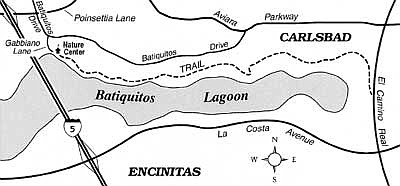 Facebook
Facebook
 X
X
 Instagram
Instagram
 TikTok
TikTok
 Youtube
Youtube
Just beyond the placid north shore of North County's Batiquitos Lagoon, white flecks of shell glint in the sunlight where the land begins to rise. Prior to around two centuries ago, and back as far as 8000 years before present, Native Americans gathered and consumed shellfish here. As generations of Indians discarded the shell remains, their middens (refuse piles) grew in size. They remain in evidence today, right alongside the lagoon's shoreline trail.
The Batiquitos Lagoon of prehistoric and early historic times lived up to its "lagoon" moniker. Seawater surged in and out on the tides, alternately bathing and uncovering the low-lying, salt-tolerant vegetation. For most of the past century, however, vast loads of soil loosened by agricultural activity and urban development on the lagoon's watersheds were flushed downstream during winter floods. Much of that silt dropped out of suspension near the lagoon's mouth, forming a plug that turned the lagoon into a stagnating freshwater lake.
In a giant leap backward, or forward as the case may be, a massive dredging and lagoon restoration project -- billed as one of the most significant efforts of its kind in the nation -- restored the lagoon to its prehistoric status in the past decade. Dredged sand and silt was piled up near the south shoreline to provide nesting sites for least terns and western snow plovers. Jetties were built at the lagoon's entrance to facilitate and maintain tidal flows.
Hikers and runners (horses and bicycles are not allowed) can explore the wide path along the lagoon's north shoreline anytime during daylight hours. You can start from the Batiquitos Lagoon nature center at the end of Gabbiano Lane in Carlsbad, or gain access to the middle sections of the trail from four parking lots along Batiquitos Drive. The wide, nearly level public trail curls along the lagoon's north shoreline to a point about two miles east of the nature center. From there, an informal trail continues another mile to El Camino Real.
The lagoon's nature center is open for visitation Wednesday through Friday, noon to 4 p.m., and Saturday/Sunday, 10 a.m. to 2 p.m. Call 760-931-0800 for more information.


Just beyond the placid north shore of North County's Batiquitos Lagoon, white flecks of shell glint in the sunlight where the land begins to rise. Prior to around two centuries ago, and back as far as 8000 years before present, Native Americans gathered and consumed shellfish here. As generations of Indians discarded the shell remains, their middens (refuse piles) grew in size. They remain in evidence today, right alongside the lagoon's shoreline trail.
The Batiquitos Lagoon of prehistoric and early historic times lived up to its "lagoon" moniker. Seawater surged in and out on the tides, alternately bathing and uncovering the low-lying, salt-tolerant vegetation. For most of the past century, however, vast loads of soil loosened by agricultural activity and urban development on the lagoon's watersheds were flushed downstream during winter floods. Much of that silt dropped out of suspension near the lagoon's mouth, forming a plug that turned the lagoon into a stagnating freshwater lake.
In a giant leap backward, or forward as the case may be, a massive dredging and lagoon restoration project -- billed as one of the most significant efforts of its kind in the nation -- restored the lagoon to its prehistoric status in the past decade. Dredged sand and silt was piled up near the south shoreline to provide nesting sites for least terns and western snow plovers. Jetties were built at the lagoon's entrance to facilitate and maintain tidal flows.
Hikers and runners (horses and bicycles are not allowed) can explore the wide path along the lagoon's north shoreline anytime during daylight hours. You can start from the Batiquitos Lagoon nature center at the end of Gabbiano Lane in Carlsbad, or gain access to the middle sections of the trail from four parking lots along Batiquitos Drive. The wide, nearly level public trail curls along the lagoon's north shoreline to a point about two miles east of the nature center. From there, an informal trail continues another mile to El Camino Real.
The lagoon's nature center is open for visitation Wednesday through Friday, noon to 4 p.m., and Saturday/Sunday, 10 a.m. to 2 p.m. Call 760-931-0800 for more information.
